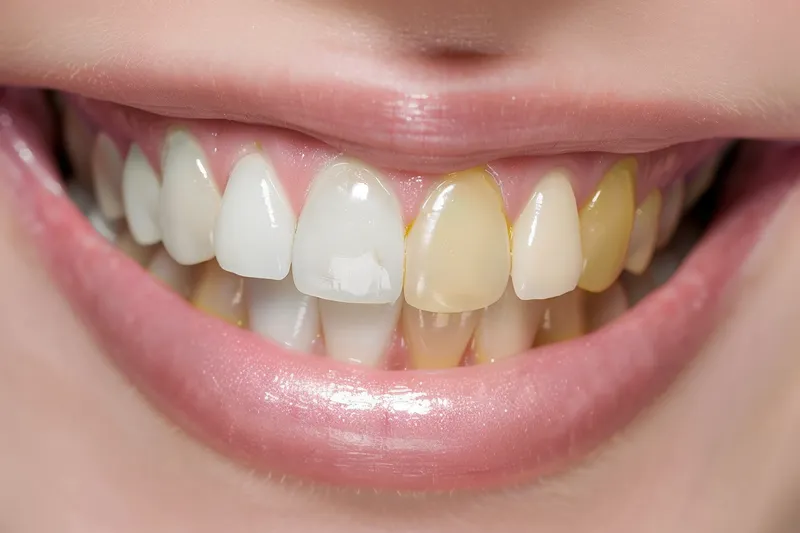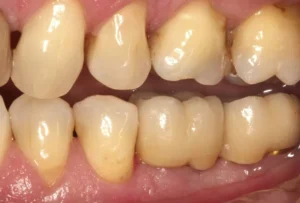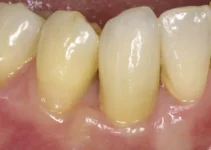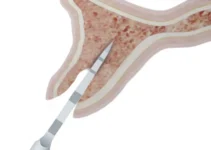Many people find themselves struggling with yellow teeth, which can affect both their confidence and oral health. The discoloration can be caused by a variety of factors including certain foods and beverages, smoking, inadequate brushing, and genetic predispositions. In this article, we’ll explore the main causes of yellowing teeth and provide practical tips on how to prevent this common dental issue. Understanding these preventive measures can help maintain a whiter, healthier smile.
Causes of Yellow Teeth
Yellow teeth can be a source of embarrassment and concern for many individuals. Understanding the causes of yellow teeth is crucial in maintaining good oral hygiene and preventing further discoloration. The following sections delve into the primary factors that contribute to yellow teeth, including poor oral hygiene and diet and lifestyle choices. 
Identifying the root causes can help in adopting better habits and treatments to restore the natural whiteness of your teeth.
Poor Oral Hygiene
Poor oral hygiene is one of the leading causes of yellow teeth. When you don’t brush and floss your teeth regularly, plaque buildup occurs, leading to dental stains. Plaque is a sticky film of bacteria that can harden into tartar, which is more challenging to remove and can discolor your teeth.
Regular brushing, flossing, and professional cleanings can help prevent plaque buildup. The American Dental Association recommends brushing your teeth twice a day and flossing at least once a day to maintain good oral hygiene. Neglecting these habits not only leads to yellow teeth but also to more serious dental problems like cavities and gum disease.
Diet and Lifestyle Choices
Your diet and lifestyle choices significantly impact the color of your teeth. Certain foods and beverages are notorious for staining teeth. For example, coffee, tea, red wine, and soda contain chromogens, which are compounds that adhere to enamel and cause discoloration. Additionally, acidic foods and drinks can erode enamel, making it easier for stains to set in.
Beyond diet, lifestyle choices such as smoking and tobacco use can lead to yellow teeth. The nicotine and tar found in tobacco are well-known staining agents. Smokers are also more likely to develop plaque and tartar, contributing to further discoloration. Quitting smoking and moderating the intake of staining foods and beverages can significantly improve the appearance of your teeth.
In summary, both poor oral hygiene and diet and lifestyle choices are significant contributors to yellow teeth. By adopting better oral care routines and making mindful dietary selections, you can prevent and reduce tooth discoloration.
Understanding these factors is the first step towards maintaining a bright, healthy smile. For more in-depth information on oral care and dental treatments, be sure to check out our other articles.
Preventing Yellow Teeth
Yellow teeth can be a significant source of embarrassment and may impact an individual’s self-confidence. While it is a common issue, there are several ways to prevent tooth discoloration effectively. By implementing certain habits and avoiding specific substances, one can maintain a brighter smile. The following sections will delve into practical steps you can take to keep your teeth white.
One of the primary reasons teeth become yellow is the build-up of plaque and tartar on the enamel. Additionally, certain foods and beverages can stain the teeth, making them appear dull and discolored. Adopting a comprehensive oral care routine is essential to counteract these effects. Let’s explore some critical preventative measures.
It is important to note that some people may be more prone to yellowing teeth due to their genetic makeup. Despite this, the tips outlined below can help mitigate the impact of these genetic factors. Furthermore, understanding the underlying causes can support more effective prevention strategies.
Regular Brushing and Flossing
Brushing and flossing are the cornerstones of good oral hygiene and are crucial for preventing yellow teeth. Brushing at least twice a day helps remove food particles and plaque that can lead to discoloration. It’s recommended to use a toothbrush with soft bristles and fluoride toothpaste to effectively clean your teeth without causing abrasion.
Flossing daily is equally important, as it helps eliminate food debris and plaque from areas that a toothbrush cannot reach, such as the spaces between the teeth and under the gumline. By maintaining consistent flossing habits, you can prevent plaque buildup, which is a common cause of yellowing teeth.
A comprehensive oral care routine should also include the use of mouthwash. Mouthwash can help kill bacteria that contribute to plaque formation and bad breath. Opt for an antiseptic mouthwash that targets the bacteria causing plaque, and use it as directed by your dentist.
To ensure optimal results, replace your toothbrush every three to four months or sooner if the bristles become frayed. A worn toothbrush will not clean your teeth effectively, which can lead to plaque accumulation and ultimately, teeth discoloration.
Avoiding Staining Foods and Beverages
Certain foods and beverages are notorious for causing tooth stains. Beverages like coffee, tea, red wine, and sodas contain chromogens—highly pigmented molecules that adhere to the enamel of your teeth, causing discoloration over time. Reducing the consumption of these drinks or using a straw to minimize contact with your teeth can help in maintaining a whiter smile.
Foods like berries, sauces, and candies with artificial coloring can also contribute to yellowing teeth. To counteract these effects, consider rinsing your mouth with water after consuming such foods. This can help wash away the chromogens before they have a chance to adhere to your teeth.
Additionally, tobacco products are among the most detrimental substances for teeth staining. Both smoking and chewing tobacco can lead to stubborn yellow and brown stains on your teeth. Quitting smoking and avoiding tobacco products can significantly improve the color of your teeth, along with other health benefits.
It can be helpful to maintain a balanced diet rich in fruits and vegetables that promote oral health. Crunchy fruits and vegetables like apples, carrots, and celery can act as natural abrasives, helping to clean your teeth while you eat. Moreover, these foods stimulate saliva production, which naturally helps in cleaning teeth and neutralizing acids.
Using Whitening Toothpaste
Whitening toothpaste can be an effective tool in preventing and reducing tooth discoloration. These toothpastes typically contain mild abrasives that help remove surface stains. Moreover, they often include whitening agents like hydrogen peroxide or carbamide peroxide, which can help to bleach the teeth over time.
It is essential to select a whitening toothpaste that is approved by dental associations to ensure it is safe and effective. Overuse of harsh whitening agents can lead to tooth sensitivity and enamel erosion, so it’s best to follow the guidelines provided by your dentist or the product manufacturer.
For optimal results, it is recommended to use whitening toothpaste in conjunction with your regular oral care routine. This means brushing at least twice a day, flossing daily, and visiting your dentist for regular check-ups and professional cleanings.
In addition to whitening toothpaste, there are other over-the-counter whitening products available, such as whitening strips and gels. However, it is crucial to consult with your dentist before starting any whitening regimen to ensure it is suitable for your dental health needs. Maintaining a bright smile requires consistent effort and mindful choices. By incorporating these practices into your daily routine, you can effectively prevent yellow teeth. For more tips on oral health and dental care, be sure to check out our other articles.
Treatments for Yellow Teeth
Yellow teeth can be a significant source of embarrassment and can impact one’s self-esteem. Fortunately, various treatments are available to help restore your teeth to their natural whiteness. In this article, we will discuss two primary categories of treatments for yellow teeth: At-Home Whitening Kits and In-Office Dental Treatments.
It is important to understand that the effectiveness of these treatments can vary from person to person. Factors such as the initial shade of the teeth, the underlying cause of the discoloration, and consistency in following the treatment protocol can all play a role in the results achieved. While at-home kits can be convenient and cost-effective, professional treatments often yield quicker and more dramatic results.
At-Home Whitening Kits
At-home whitening kits have become increasingly popular due to their convenience and accessibility. These kits typically include whitening strips, gels, or trays that contain peroxide-based bleaching agents. When used as directed, these products can help lighten the color of your teeth over a period of several weeks.
Several studies have shown that at-home whitening kits can be effective in reducing mild to moderate staining. The peroxide concentration in these kits is generally lower than that used in professional treatments, which can make them a safer option for those who have sensitive teeth. Commonly used chemicals in these kits include hydrogen peroxide and carbamide peroxide.
However, there are some drawbacks to consider. At-home treatments often require a longer commitment, sometimes taking up to four weeks to see noticeable results. Additionally, improper use can lead to inconsistent whitening or even gum irritation. Therefore, it is essential to follow the instructions carefully and consult with a dentist if you have any concerns.
In-Office Dental Treatments
For those seeking quicker and more reliable results, in-office dental treatments are an excellent option. These treatments are performed by dental professionals using high-concentration bleaching agents and advanced technologies, such as laser or LED lights, to accelerate the whitening process.
Professional whitening treatments can produce dramatic results in just a single visit. According to research, in-office treatments can lighten teeth by up to eight shades in as little as one hour. This makes them ideal for individuals who need to whiten their teeth for a special event or simply desire rapid results.
In-office treatments not only provide faster results but also come with the expertise of a dental professional who can tailor the treatment to your specific needs. This minimizes the risk of complications such as uneven whitening or gum irritation.
Despite their effectiveness, professional treatments can be more expensive than at-home kits. However, many patients find that the cost is justified by the quality and speed of the results. For those who are concerned about expense, many dental offices offer financing options or bundled packages that include take-home maintenance kits.
In conclusion, both at-home and in-office treatments have their own sets of advantages and limitations. To make an informed decision, it’s best to consult with your dentist, who can recommend the most suitable option based on your specific needs and circumstances. For more insights on dental health and advanced treatments, be sure to check out our other articles.
Common Questions About Yellow Teeth
If you’re concerned about yellowing teeth, you are not alone. Many people have questions about why their teeth might be changing color and what can be done about it. Here are some frequently asked questions with answers to help you understand more about this common issue.
Why do teeth turn yellow?
Teeth can turn yellow due to a variety of factors including diet, oral hygiene, and aging. Consuming foods and drinks with strong colorants like coffee, tea, and red wine can stain teeth over time. Smoking is another major cause of yellow teeth. Furthermore, as we age, the outer layer of enamel on our teeth wears down, revealing the natural, yellower color of the underlying dentin.
How can I prevent my teeth from turning yellow?
Maintaining good oral hygiene is crucial in preventing teeth from turning yellow. Brush at least twice a day and floss daily to remove plaque and food particles. Regular dental check-ups and cleanings are also vital. Limiting intake of staining foods and drinks, and avoiding tobacco products, can also help keep your teeth brighter. Additionally, consider using whitening toothpaste or treatments recommended by your dentist.

My name is Salman Kapa, a 73-year-old expert in bone regeneration and dental implantology. With decades of experience in the field, I am dedicated to advancing our understanding of oral health and hygiene. Through my research and writing, I aim to contribute to the development of innovative solutions in dental care.




